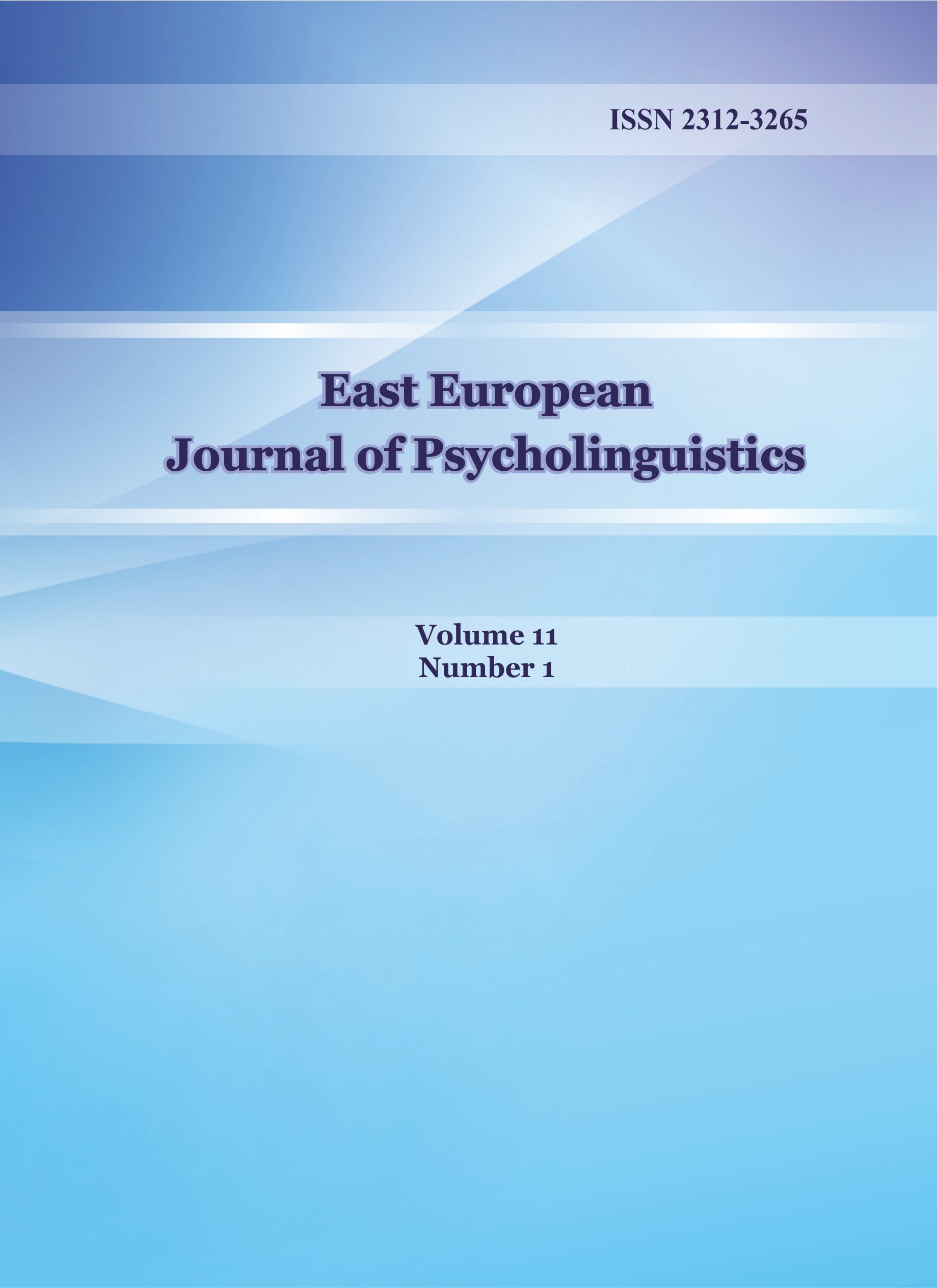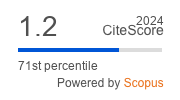Masked cognate translation priming with Arabic-English bilinguals: Further support for the morphological account
DOI:
https://doi.org/10.29038/eejpl.2024.11.1.alzKeywords:
cognates , non-concatenative, morphology, bilingualsAbstract
The aim of this study is to test the two accounts that have been posited as how cognates are represented in the bilingual mind: the mophological account and the phonological account. More specifically, this study exploits the uique feature of pluralization in Arabic (i.e., concatenative vs. non-concatenative process of pluralization) to invetigate how cognates are represented in the bilingual mind of different-script bilinguals (Arabic-English bilinguals) using the masked priming technique. Two types of cognates were used: cognates that are pluralized concatenatively and cognates that pluralized non-concatenatively in Arabic. In concatenative pluralization, the phonology of the singualr form is intact such as هرمون /hormōn/ (hormone in English), which is pluralized as هرمونات/hormōnat/ (hormones in English). On the other hand, in non-concatenative pluralization, the phonology of the singular form is broken when a word is plualized non-concatenatively as in ترم /tirm/ (term in English) and أترام atrām/ (terms in English). The results show a comparable priming effect for both types of pluralizations indicating that cognates in Arabic-English bilinguals may have a shared morphological representation since the magnitude of priming was not affected by the type of pluralization. This similar priming effect for concatenative and non-concatenative pluralization indicates that cognates may share a special kind of morphological representation as suggested by the morphological account.
Author: Alhassan Alzahrani
Downloads
References
Boudelaa, S., & Gaskell, M. G. (2002). A re-examination of the default system for Arabic plurals. Language and Cognitive Processes, 17(3), 321–343. https://doi.org/10.1080/01690960143000245
Boudelaa, S., & Marslen-Wilson, W. D. (2011). Productivity and priming: Morphemic decomposition in Arabic. Language and Cognitive Processes, 26, 624-652. https://doi.org/10.1080/01690965.2010.521022
Boudelaa, S., & Marslen-Wilson, W. D. (2005). Discontinuous morphology in time: incremental masked priming in Arabic. Language and Cognitive Processes, 20(1–2), 207–260. http://dx.doi.org/10.1080/01690960444000106
Crepaldi, D., Rastle, K., Coltheart, M., & Nickels, L. (2010). Fell primes fall but does bell prime ball? Masked priming with irregularly-inflected primes. Journal of Memory and Language, 63, 83–99. http://dx.doi.org/10.1016/j.jml.2010.03.002
Davis, C. J. (2005). N-watch: A program for deriving neighborhood size and other psycholinguistic statistics. Behavior Research Methods, 37, 65–70. http://dx.doi.org/10.3758/BF03206399
Davis, C., Sánchez-Casas, R., Garcia-Albea, J. E., Guasch, M., Molero, M., & Ferré, P. (2010). Masked translation priming: Varying language experience and word type with Spanish-English bilinguals. Bilingualism: Language and Cognition, 13, 137–155. http://dx.doi.org/10.1017/S1366728909990393
De Groot, A. M. B., & Nas, G. L. J. (1991). Lexical representations of cognates and noncognates in compound bilinguals. Journal of Memory and Language, 30, 90–123. https://doi.org/10.1016/0749-596X(91)90012-9
De Groot, A. M. B., & Van Hell, J. G. (2005). The learning of foreign language vocabulary. In J.F. Kroll & A. M. B. De Groot (Eds.), Handbook of bilingualism: Psycholinguistic approaches. (pp. 9–29). Oxford University Press.
Ferré, P., Sánchez-Casas, R., Comesaña, M., & Demestre, J. (2017). Masked translation priming with cognates and noncognates: Is there an effect of words’ concreteness? Bilingualism: Language and Cognition, 20(4), 770-782. https://doi.org/10.1017/S1366728916000262
Forster, K. I., & Davis, C. (1984). Repetition priming and frequency attenuation in lexical access. Journal of Experimental Psychology: Learning, Memory, and Cognition, 10, 680–698.
Forster, K. I., & Forster, J. C. (2003). DMDX: A Windows display program with millisecond accuracy. Behavioral Research Methods, Instruments, & Computers, 35, 116-124. https://doi.org/10.3758/BF03195503
Frost, R., Forster, K. I., & Deutsch, A. (1997). What can we learn from the morphology of Hebrew? A masked-priming investigation of morphological representation. Journal of Experimental Psychology: Learning, Memory, and Cognition, 23, 829-856. http://dx.doi.org/10.1037//0278-7393.23.4.829
García-Albea, J. E., Sánchez-Casas, R. M., & Igoa, J. M. (1998). The contribution of word form and meaning to language processing in Spanish: Some evidence from monolingual and bilingual studies. In D. Hillert (Ed.), Sentence processing: A cross-linguistic perspective (pp. 183–209). New York: Academic Press.
Gollan, T. H., Forster, K. I., & Frost, R. (1997). Translation priming with different scripts: Masked priming with cognates and noncognates in Hebrew-English bilinguals. Journal of Experimental Psychology: Learning, Memory, and Cognition, 23, 1122–1139. https://doi.org/10.1037/0278-7393.23.5.1122
Holes, C. (1995). Modern Arabic. Longman.
Kim, J., & Davis, C. (2003). Task effects in masked cross-script translation and phonological priming. Journal of Memory and Language, 49, 484–499. http://dx.doi.org/10.1016/S0749-596X(03)00093-7
Koutamanis, E., Kootstra, G. J., Dijkstra, T., & Unsworth, S. (2024). Shared representations in cognate comprehension and production: An online picture naming and lexical decision study with bilingual children. Applied Psycholinguistics, 1–27. http://dx.doi.org/10.1017/S0142716424000158
Kroll, J. F., & de Groot, A. M. B. (Eds.). (2005). Handbook of bilingualism: Psycholinguistic approaches. Oxford University Press.
Lemhöfer, K., & Broersma, M. (2012). Introducing LexTALE: A quick and valid lexical test for advanced learners of English. Behavior Research Methods, 44, 325-343. https://doi.org/10.3758%2Fs13428-011-0146-0
McCarthy, J., & Alan S. Prince. (1990). Foot and word in prosodic morphology: The Arabic broken plural. Natural Language & Linguistic Theory, 8(2), 209-283. https://doi.org/10.1007/BF00208524
McCarthy, J. (1979). Formal Problems in Semitic Phonology and Morphology. Ph.D. dissertation. Cambridge, MA: MIT
Nakayama, M., Sears, C., Hino, Y., & Lupker, S. (2013). Masked translation priming with Japanese–English bilinguals: Interactions between cognate status, target frequency and L2 proficiency. Journal of Cognitive Psychology, 25(8), 949-981. http://dx.doi.org/10.1080/20445911.2013.839560
Nakayama, M., Verdonschot, R. G., Sears, C. R., & Lupker, S. J. (2014). The masked cognate translation priming effect for different-script bilinguals is modulated by the phonological similarity of cognate words: Further support for the phonological account. Journal of Cognitive Psychology, 26, 714-724. http://dx.doi.org/10.1080/20445911.2014.953167
Poort, E. D., & Rodd, J. M. (2017). The cognate facilitation effect in bilingual lexical decision is influenced by stimulus list composition. Acta Psychologica, 180, 52-63. http://dx.doi.org/10.1016/j.actpsy.2017.08.008
Rastle, K., Harrington, J., & Coltheart, M. (2002). 358,534 nonwords: The ARC Nonword Database. Quarterly Journal of Experimental Psychology, 55A, 1339-1362. http://dx.doi.org/10.1080/02724980244000099
Sánchez-Casas, R. M., Davis, C. W. & García-Albea, J. E. (1992). Bilingual lexical processing: Exploring the cognate/non-cognate distinction. European Journal of Cognitive Psychology, 4, 293-310. https://doi.org/10.1080/09541449208406189
Sánchez-Casas, R., & García-Albea, J. E. (2005). The representation of cognate and noncognate words in bilingual memory: Can cognate status be characterized as a special kind of morphological relation? In J. F. Kroll & A. M. B. De Groot (Eds.), Handbook of bilingualism: Psycholinguistic approaches (pp. 226–250). New York: Oxford University Press.
Voga, M., & Grainger, J. (2007). Cognate status and cross-script translation priming. Memory & Cognition, 35, 938–952. https://doi.org/10.3758/BF03193467
Vanlangendonck, F., Peeters, D., Rueschemeyer, S. A., & Dijkstra, T. (2020). Mixing the stimulus list in bilingual lexical decision turns cognate facilitation effects into mirrored inhibition effects. Bilingualism: Language and Cognition, 23(4), 836–844. http://dx.doi.org/10.1017/S1366728919000531
Zhang, J., Wu, C., Zhou, T., & Meng, Y. (2018). Cognate facilitation priming effect is modulated by writing system: Evidence from Chinese-English bilinguals. International Journal of Bilingualism, 1-14. https://doi.org/10.1177/1367006917749062
Downloads
Published
Issue
Section
License
Copyright (c) 2024 Alhassan Alzahrani

This work is licensed under a Creative Commons Attribution 4.0 International License.














 Creative Commons «Attribution» 4.0
Creative Commons «Attribution» 4.0